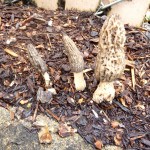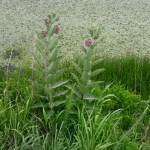Not too long ago, I watched a brief video created by our local public broadcasting station featuring footage of the Bull Run watershed. Nestled in the lower slopes of Mt. Hood and surrounding regions, this watershed provides Portland and other local communities with our superbly clean tap water. It’s closed to the public to protect the land and water from pollution, so few people have actually seen what’s in this vast, fenced-off area. Oregon Public Broadcasting got a rare opportunity to film parts of it to show the rest of us what we’re missing out on.
The video showed some unexpected sights, to include a couple of abandoned stone fountains, but the part that impressed me the most was the river itself. Clear and beautiful, it splashes through an idyllic northwest conifer forest. I also didn’t realize just how small it was, at least where it was filmed. Of course, it gets bigger as more streams feed into it further on. But I was struck by the vulnerability of our water source, fed from rain and snow melt, and it made me review my own use of this limited commodity.
See, we take water for granted all too often. We assume there’s enough for everything from drinking to watering golf courses in the desert to agriculture in the former Dust Bowl. But the Colorado River no longer reaches its terminus in the Sea of Cortez, the water table that feeds the Midwest has been severely depleted in less than a century, and yet we keep using fresh water like it’ll never run dry. Some people talk about desalinating ocean water, but this doesn’t address the ecosystems where the fresh water has been so depleted that they’re permanently damaged; we only think of ourselves.
Much of the water use is due to agricultural irrigation and livestock watering, as well as various industrial uses. However, we as consumers go through a lot of water as well, and while we can call on corporations to change their methods, we can also make more immediate changes closer to home.
The Water We Use
The average American family uses 400 gallons of water every day. Think of 400 gallon jugs stacked in your living room, and then multiply that just by the number of households in your neighborhood, and then perhaps by 365 days in a year. That’s a lot of water! Of course, individual use may vary according to family size, time of year, and other factors, but we can do our part to lower that average.
First, look at water usage that isn’t particularly necessary. Lawns, as one example, are one big water waste. Unless you live in a neighborhood with a landlord or homeowner’s association that monitors every little detail of your home’s appearance, there’s no real reason to water your lawn in the summer. And if the grass gets less water, it doesn’t grow as quickly, which means less mowing and upkeep, too! If you absolutely must have a pretty yard, consider doing some landscaping with succulents and other plants that don’t need as much water as a grass lawn, or native species that are used to the local rainfall. Or if you want to put that land and water to good use, turn your yard into a “yarden”, full of all sorts of edibles to cut down on your grocery bill!
You can also cut down on your everyday water use in other ways. While new, low-volume flushing toilets use only a couple of gallons of water per flush, older ones can use six or seven gallons. One way to reduce this is to take a gallon milk jug or juice bottle and fill it with water with some gravel at the bottom for extra weight so it won’t float. Next time you flush, wait until the tank is empty and then put the bottle in. It’ll make the tank stop filling faster. If you have room, rubberband one or two smaller bottles of water to that one, or tuck a couple of large, flat stones leaning against the inside wall of the tank. All these will cut down on the amount of water the tank needs to be full, but will still allow enough water volume for each flush to be effective.
You’ve probably heard about turning the water off while you brush your teeth (what’s that water doing anyway? Just going down the drain!) You can also turn the water off while you scrub your hands with soap–just wet your hands, turn the water off, lather up, and then turn the water back on to rinse. If you get soap on the sink handle, just splash a little rinse water on it. Same thing goes for showering–wet yourself down, turn the water off to shampoo your hair and clean everything else, then back on for rinsing. (This may, of course, be more challenging in cold weather when some of us rely on the water to stay warm!)
Finally, you can reuse water that might otherwise be wasted. Few of us like a cold shower, and depending on how far your hot water heater is from your bathroom, it may take several seconds for the water to heat up. Keep a bucket in the bathroom, and put it under the tub tap while the water warms up. Then you can switch to the shower once it’s warm, and use the cold water for gardening and houseplants, or to help refill the toilet tank after a flush.
What’s In the Water?
The other part of the equation is what we send out in the water once we’re done with it. Obviously, some things (like waste) are unavoidable. But we have choices with many of the other things we often send down the drain.
Let’s take soap, for an example. From laundry detergent to shampoo, we use a lot of products for cleaning. Those don’t just magically disappear once our shower is done or the laundry’s dry. The chemicals continue down the pipes, and depending on how effective (or not) your local water treatment system is, they may make it into the wild waters in your area. Many commercial soaps have a variety of artificial components that aren’t just born out of some really nasty chemical processes (with equally bad byproducts), but which can stay persistently in the environment for years.
One way to counteract this is to buy shampoos and soaps made from organic materials, or at the very least that don’t have additives like sulfates (which are common surfactants that strip away oil, dirt, and create foaming). These don’t have to be salon-quality organics, either. Trader Joe’s and other eco-friendly stores often have several options which are comparable in price and effectiveness to the average “normal” store-bought shampoos and soaps, and you can even find recipes to make your own online. Similarly, there are more green options for laundry detergents, dish soaps, and the like.
Speaking of cleaning, what about household cleansers? Most of these are based in things like ammonia and bleach, neither of which are very friendly. A simple vinegar/water mix works well for most household cleaning projects, and for abrasion Bon Ami or baking soda are good choices, along with steel wool for really stubborn messes. And once you wash your cleaning rags, the traces of vinegar and baking soda are a lot better for the water system than ammonia and bleach. (By the way, using reusable cleaning rags instead of paper towels also cuts down on water use–there’s a lot of water involved in the process of turning trees into disposables!)
Finally, do your very best to avoid things like Drano and other harsh chemical cleaners in your pipes. Pipe snakes are inexpensive (I got a plastic one for a couple bucks that’s worked very well), and between that and a plunger most clogs can be easily dealt with. You can pour boiling water down the drain to get rid of clogs as well, or for regular maintenance.
I’ve hardly listed all the ways we can preserve the fresh water we do have (and which we need to live!) What other suggestions do you readers have?












